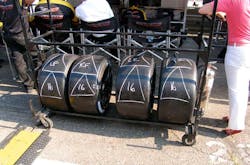Paddock talk with Silvia Mammone: Part II
In this segment of our discussion with Ms. Mammone, Michelin's Motorsports and Sponsorship Manager in North America, we focus on Michelin's technical developments in ALMS racing.
The new Street Soft compound is very successful, why is it called “Street Soft”?
Mammone: The street soft is a tire compound that came about when we learned that we were going to be going to Long Beach. Long Beach is a very short race, there is not a lot of track time, it’s a street circuit, it’s in April in California and we needed a tire that could come up to temperature very quickly. There is not a lot of time on the track at Long Beach to get the heat in the tire so it came about in a very interesting way but we found ourselves with a tire that could heat up very quickly and maintain that performance level which the drivers needed and that became the street soft.
This goes right back to the whole idea of learning and finding new knowledge to make tires that work and the teams are finding other ways to use the street soft compound tires now.
Tell us about another development, the new tall tire?
Mammone: The new tall tire is for GT, the Grand Touring class, which has a new construction making a taller tire. All the teams are using it now. It allows them a bigger contact patch and it allows them to get more performance out of the tire. The tall tire came about because of a rule change which allowed for a wider body. This allowed us to make a tire to take advantage of that.
What is the role of driver feedback in this time of increased electronic/computing controls?
Mammone: There is what the electronics can give you and there is what the driver can give you, sometimes they match and sometimes they don’t but driver feedback is always important. The electronics have really developed but the driver has a different sense of it all, it’s almost magical because he can tell you based on his own personal experience, his gut feeling, about things that just aren’t trackable with electronics.
Is this input especially valuable when you are testing a new tire?
Mammone: Absolutely, the test driver can tell you what the tires feel like, what tire grips well, what tire turns-in well, things that the computers can’t define. That human aspect will always be important to us .
What is the timeline between racing tire development and the engineering of the successful developments into consumer products like today?
Mammone: With race tires we are always developing, there is always something we’re working on. Looking at just this year, we’ve introduced the narrow Delta wing tire, the taller GT tire, we introduced the hybrid tire and we introduced the new slick rain tire. And the consumer benefits from this technology.
I don’t think we can put a timeline on it but I think we can definitely say that we see that transfer occurring. We try very hard to keep our consumer products updated. In a market that is very cluttered and very competitive with a lot of players we need to push that next generation of consumer products. They both work hand-in-hand because we are continually evolving to meet the needs that the consumer has and the motorsports engineering is likely where we will find the innovations to fill those consumer markets needs.
One of the things we do at Michelin as I’ve mentioned , is put a race engineer at every one of our teams. That is very important because that engineer becomes part of the team and is integrated very quickly. Their role is to advise the team as to the choices of tires they can use, take care of the tires data, suggest compounds etc. but the engineers themselves are not part of our motorsports staff. They are participants in Michelin’s ‘weekend warriors’ program. Apart from this program they all have day jobs at Michelin and they range from tire designer to release to chemical engineer to the whole breath of roles at Michelin. They take time from their day jobs to come to the races and work with the teams because they are passionate about racing and embrace the racing heritage of Michelin. What they are learning at the race track they are able to apply in to their day jobs at Michelin.
We have for example Lee Willard who has been the race engineer for Corvette for a number of years and he takes what he is learning about the behavior and performance of the tires on track and applies it in designing the street tire for the ZR1 Corvette. There is a natural flow of knowledge that these guys get and it may not in every case be applies directly but they draw on it as needed in they work for Michelin . It’s all part of that circle of knowledge which benefits all our product lines at Michelin.
From your viewpoint what will be the next big trend in ALMS and racing in general?
Mammone: I think the next big trend is going to be the hybrid technology , the evolution of that. We saw it first at Le Mans with Audi and Toyota and I think that is something that both consumers and manufacturers are looking seroiusly at. In tires, we saw the out-of-the-box thinking of the four inch Delta Wing tire , that was something that wasn’t in our toolbox, we had to reach, we had to work very hard to get to that point but once again you are seeing that evolution of tires and hybrid technology.
